You just finished your latest building project, whether it was a beautiful cedar fence or an outdoor shed. Right now, it is beautiful and new, but things can change over the course of time. You want to make sure that you are doing everything you can to protect your latest investment from something dreadful. In other words, you need to learn how to stop wood rot in its tracks.
Stopping wood rot does not require much effort if you are planning in advance. It is important to know what causes wood rot so that you can take the necessary precautions before you begin to build. If you want to make sure that your next project isn’t compromised, keep reading to learn more about what causes wood rot and how you can prevent it.
What Causes Wood Rot?
 While many homeowners work themselves into a panic when it comes to wood rot, it is actually a very natural process. Wood rot takes place in nature so that fallen trees can be broken down back into the earth. They transform from solid structures back into loose and nutritious soil that allows new plants to burst forth from the ground. However, this can indeed be a scary prospect when it comes to wood rot in your home.
While many homeowners work themselves into a panic when it comes to wood rot, it is actually a very natural process. Wood rot takes place in nature so that fallen trees can be broken down back into the earth. They transform from solid structures back into loose and nutritious soil that allows new plants to burst forth from the ground. However, this can indeed be a scary prospect when it comes to wood rot in your home.
Understanding where wood rot comes from can help you to make changes to eliminate the circumstances that cause it. If you can keep your wood from being subject to these conditions, it is more likely that you will be able to stop wood rot from spreading.
The major reason that wood tends to rot is because of moisture. When the wood is damp continuously, it also invites fungi to feast upon the wood. Depending on what type of fungi claim your wood products, you might have one of three different types of wood rot in your home.
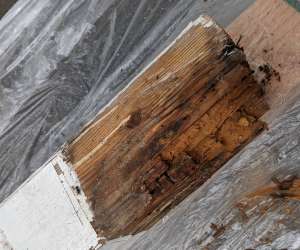
Keep in mind that dry rot tends to spread at a very fast pace, so if you see the telltale signs of these cube-shaped pieces, you need to call in a professional immediately.
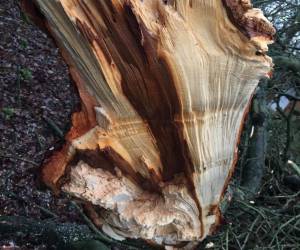
White rot on oak.
White rot is notorious for changing the wood to a light-yellow hue and giving it a spongy texture. Instead of consuming cellulose, this type of fungi instead targets the lignin and leaves the cellulose behind. It also occurs in warmer temperatures, much like brown rot.
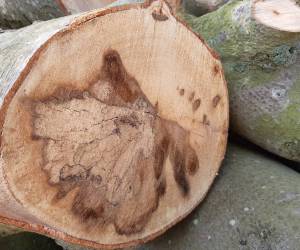
A pattern of soft rot.
There is also soft rot, which is not commonly found in houses but does still pop up sometimes. It is a slow type of decomposition. This type of fungi thrives in all sorts of temperatures ranging from 0 to 110-degrees Fahrenheit.
Over time, it slowly breaks down cellulose, and only a weak honeycomb structure is left behind. What is left over is not going to be strong enough to support much weight and can easily give, creating a dangerous situation for you at home.
Can Wood Rot Be Stopped?
Knowing what causes wood rot is an important first step in stopping the rot in its tracks. Because moisture is the key element that invites the fungi in to feast upon the wood, you must make sure that you are not allowing moisture into the home. There are a few high-risk areas that you should regularly check to see that they are not wet or damp.
If you are concerned about dealing with wood rot inside, then you might want to check your windows first. Modern windows do not frequently have leaks, but older windows might. If you find that you have a small area where water pools up on your horizontal sills, then you need to caulk around your window. This wood is not exposed to air or sunlight because it is inside your home, and this makes it the ideal breeding ground for fungi and rot.
Basements are another key indoor area that can be highly affected by wood rot. They often have high humidity levels and moisture because they are surrounded by rich soil. Add in a few small leaks, and you have a recipe for disaster. Once you have water vapor forming on the walls or ceiling joists, you are likely to see rot slowly develop. Take care of it as soon as you notice it beginning to form, or it can cause major structural damage.
On the other end of the house, your attic and roof might be allowing for quite a bit of wood rot. Missing or damaged shingles allow water to roll right in, ruining the roof decking. As the rot progresses, it may move into the lumber that is used to frame out the trusses of your attic. If you need a simple roof repair, it is best to take care of it right away to avoid some of the major structural damages you might encounter with wood rot.
How to Stop Wood from Rotting Outside
When you are building something outside, there are different rules that you may want to consider applying to your latest project to prevent wood rot. Learning how to stop wood rot is important, but prevention is actually key. Here are a few of the precautions that you should take if you want to avoid dealing with this issue later on down the road.
First, you need to be conscious of always using decay-resistant or pressure-treated lumber for outdoor projects. If it is going to come in contact with the ground, such as fence posts, you must use lumber that is specifically rated for ground contact. This is the best way to stop a wood post from rotting in the ground.
If you are going to be building a project that remains outside, it is best to stain or paint all sides before you put the final project together. This protects the wood and makes it less susceptible to absorbing moisture and creating a habitable home for fungi to flourish.
For homes that are constructed with wood siding, you should never make a habit of leaning anything against it. This can include old lumber, tools, and even ladders. The reason for this is two-fold. Leaning these items up against the siding might trap water against the house and cause rot. On the other hand, it may damage the paint or stain and allow water to infiltrate the wood itself. Both are recipes for disaster when it comes to wood rot.
Last but not least, you need to clean your gutters regularly to prevent clogs. If the water cannot flow freely through your gutters, it might back up onto your fascia and siding, causing wood rot. A gutter repair can be a relatively easy fix for a handy homeowner. All you need to do is clean them out and make sure they are properly attached to the perimeter of your home.
Stop Wood Posts from Rotting
If you need to know how to stop wood rotting in the ground, there are a few additional steps you might need to take. These can be helpful if you are building something with a foundation beneath grade level or are sinking posts for a fence. You want to avoid common mistakes that will allow the wood to rot beneath the surface where your eye cannot see it, compromising the integrity of your new project.
The most important thing you can do is purchase the right type of lumber. It should be decay-resistant or pressure-treated lumber specifically designed for ground contact. However, there are some additional treatments you should consider applying at home.
There is a wood treatment that you can find at many home improvement stores or paint centers known as copper naphthenate. The popular name brand version of this is Cuprinol. You will want to soak the bottom of the posts in this preservative to keep them in great shape.
From here, you will want to place about six inches of aggregate into the post hole so that there is some drainage around the wood. This prevents the moisture from building upon the surface of the wood and inviting fungi in to consume it. The bottom of the post should extend into the aggregate. Finally, concrete is poured up to the soil level.
Around the edges of the post where it meets the newly poured concrete, you will want to caulk the gap. You can use exterior acrylic latex caulk or silicon that will adhere to the concrete. Make sure you wait until the concrete is completely dry to apply this ingredient.
Spotting Wood Rot
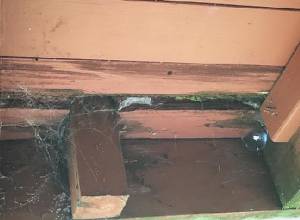
An example of why you should not tile over wood decks.
Sometimes, it is hard to avoid the fact that wood rot does happen. Despite your best efforts to keep moisture levels under control, water can seep in and invite fungi to the party. Knowing how to stop wood rot is important, but correcting the issue will be just as significant. Be patient with yourself if you must make repairs to damaged areas and try to take new steps to prevent contact with moisture in the new spots.
If you have severe wood rot issues in a major structural part of your home, consider enlisting the help of a professional. They can help you to pinpoint the root cause of your issue and help you to safely restore this area of your home. Don’t hesitate to reach out for professional help if you need it!
- How to Cut Lexan - September 25, 2020
- Mineral Spirits vs. Mineral Oil - September 25, 2020
- Shellac vs. Polyurethane - September 24, 2020

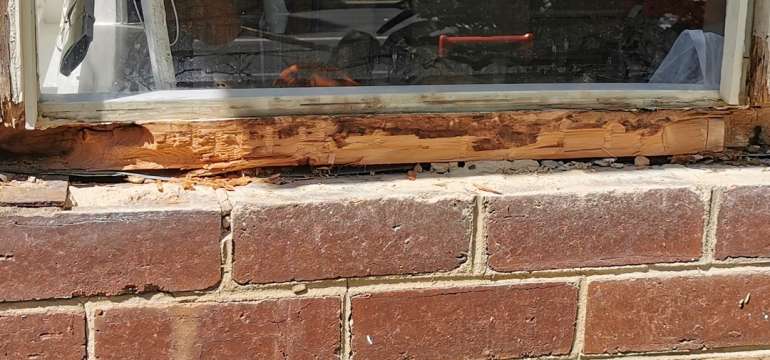
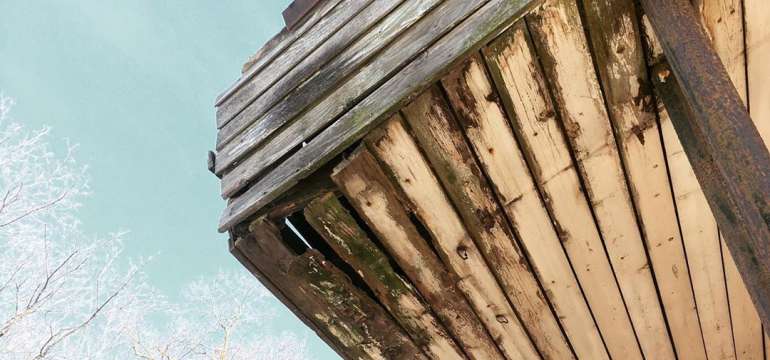
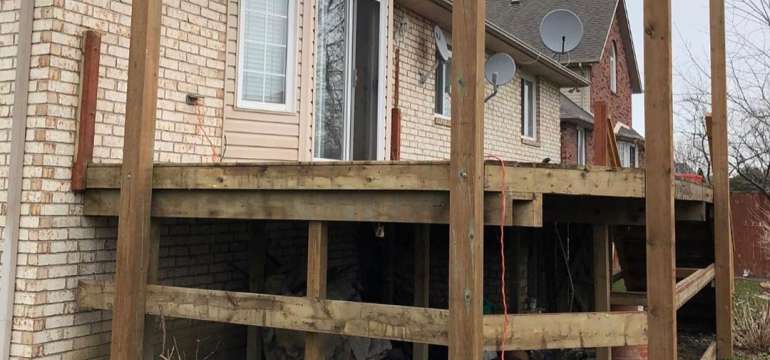
Jeff
Friday 1st of April 2022
I’ve got wood rot (maybe from carpenter ants) in the top of my 6 x 6 posts, holding up the deck. They are also the supports for the deck railing. I just took the cap boards off the railing, and the centers of the 6 x 6s are rotten down to about 3 to 5 inches. I’m not sure if it’s just rot, or if carpenter ants have been in it.
I was going to pour ant poison and wood preservative into the holes. Then maybe fill the holes with something. What should I use to fill the holes? These 6 x 6s are anywhere from 6 to 16 feet in length, and go into the ground 30”, and are set in concrete. They are very very solid. They have been in place 35 years. Any advice appreciated. Thanks